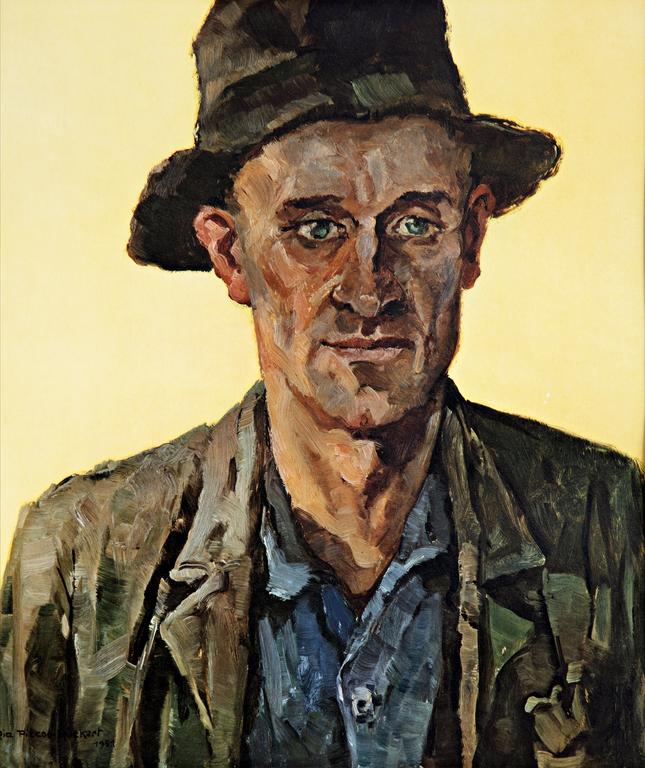Ria Picco-Rückert: Porträt eines Mannes, 1951 (Portrait of a Man)

Oil painting, 61 x 72 cm
Contemporary History at the academy: It presents three portraits of workers by Ria Picco-Rückert and the portrait of a worker, all of which were created after the war in 1951. This worker stands in contrast to Picco-Rückert's other pictures at the academy: he is the main motif, simple and clean, dressed according to his time and profession, looking tired and pensive, past the viewer. One perceives him as a person and as a human being. He is thus an exception, although workers also play a role in Picco-Rückert's other works at the academy: There she depicts people working in a steel mill in the dark, which is only broken by the glow of the iron. Overpowering, seemingly cold machines dominate the scene. The silhouettes of workers merge with their living world and merge into it. The harsh conditions under which these people earned their living become tangible in Picco-Rückert's pictures.
Ria Picco-Rückert (*1900 in Nuremberg, †1966 ibid., Germany) was known as an "industrial painter". She studied at the Nuremberg School of Arts and Crafts and, after working at academies in Stuttgart, Vienna and Weimar, became a freelance artist in Nuremberg. Her works depict the old iron and mining industry. In her forty-year career, she probably painted between 3,000 and 6,000 pictures. Picco-Rückert's portraits and wall paintings from the early years were almost exclusively replaced by representations of heavy industry, beginning in 1927. She found her motifs on the Rhine and Ruhr, on the Saar, in Alsace-Lorraine and Upper Silesia. Steel and rolling mills, blast furnaces, bridges and machines were Picco-Rückert's subjects, with the creative people at their workplaces. Between 1929 and 2006, over 60 exhibitions of hers were shown.
Yet she is not without controversy, for she was also successful in the Third Reich. Her motifs from heavy industry, but also her formal language at the time, fitted perfectly with the propaganda of the National Socialists. With more than 20 works, she was represented in large art exhibitions. Joseph Göbbels (among others head of the Reich's propaganda department and president of the Reich Chamber of Culture) and Albert Speer (among others architect of the monumental buildings and Reich Minister for Armaments and Ammunition), both of whom were trusted by Adolf Hitler, bought her paintings. Although Picco-Rückert was never a party member, she allowed herself to be put in the service of the system. According to her, her paintings were only meant to show the state of the art and working worlds.
Even after the war, she was able to continue her success for the time being. In the course of time, however, artistic taste had changed, so that she died impoverished in 1966, after private strokes of fate.